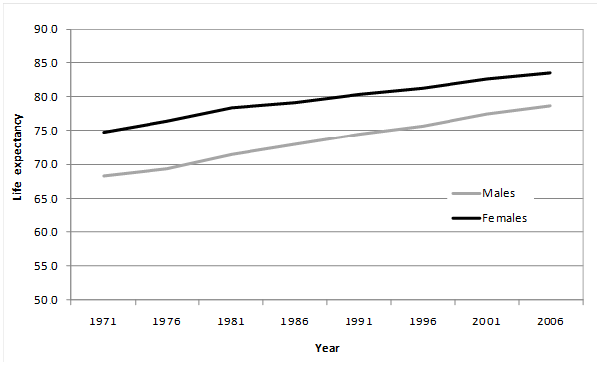We are living longer than ever before but there is significant controversy regarding the likelihood of continued increases in life expectancy. In general terms, survival rates (share of persons living to next year by age) have increased in all age groups leading to higher life expectancy for both men and women. How much older can we get?

The data suggests that although women are expected to continue to outlive men, the gap between men and women is set to close further. The reasons for this change include improvements in treatment for ischaemic heart disease and strokes. This has a greater impact in improved health outcomes for men than women due to the disproportionate number of men affected with these problems, especially at younger ages(50s, 60s and 70s). There is also a belief that a relatively greater share of men are engaging in lifestyles that expose them to greater risk (smoking, long work hours, less exercise, stress etc.). See below.
Life expectancy at birth, Australia, 1971-2006

Source: ABS, Australian Historical Population Statistics, 2008 (Cat. No. 3105.0.65.001)
There is significant controversy regarding the likelihood of continued increases in life expectancy. It is safe to assume that continued medical improvements will occur to enhance treatment of illness and disease, especially in areas such as cancer therapies. Yet, this long standing improvement to life expectancy in Australia for both men and women is not likely to occur without some challenges. These include:
- No foreseeable increase in maximum life span (only a minute share of the population lives beyond 110)
- Difficulty in reducing infant mortality further
- Difficulty in reducing accidental deaths, suicide and drug-related deaths further
- Chance of major global health problems, such as an influenza pandemic
- Rise of antibiotic-resistant infections
- Increasing problems created by over-consumption and affluence, such as obesity and diabetes
When we are undertaking population forecasts we have to make assumptions about future mortality rates that takes into account this uncertainty. In our recently completed tops-down population forecasts for Australia (SAFi), we have assumed that by 2036 life expectancy is 84 for males and 87.2 for females. This assumes a relative slowdown in life expectancy compared to current trends. These assumptions are relatively consistent with those assumed by the Australian Bureau of Statistics (ABS) in one of their series from their latest projections (Cat. No. 3222.0 – Population Projections, Australia, 2006 to 2101). Their assumption is life expectancy increasing to 85 for males and 88 for females by 2051.
So what does this all mean? Of course, this means a greater share of the population in Australia will be elderly in the future. However, recent trends show there has been a large increase in births and a large increase in overseas migration to Australia. Data from the 2001-2006 period also suggests that Australia may even lose persons overseas in the older age groups 50+ (overseas migrants returning to their place of birth?). This highlights the potential for volatility in the age structure trends and the degree to which Australia ages in the future. We will explore this theme further in the coming months…….
If you need any assistance with understanding the data in profile.id, feel free to contact the population experts at .id (03) 9417-2205 or info@id.com.au. And do follow us on Twitter @dotid or check out our website at id.com.au for more information about population change in Australia.











